The boundary conditions must be assigned differently for the two calculation phases. In the first phase, the boundary conditions of a classical finite element analysis are assigned, such as pinned joint on the lower edge and pinned support with a perpendicular axis to the edge, along the lateral surfaces. In the second phase, these constraints must be supplemented by damping contours, which have the function of limiting the effects of reflection of seismic waves at the edges of the model, which only have a numerical character but do not actually occur in situ.
To apply constraints, you must select the nodes of interest (‘Select node group’ button from the Tools panel) and then click on ‘Add constraints’.
Phase 1
The purpose of this phase is to calculate the initial stress state of the problem under consideration. In this phase, the boundary conditions are assigned as shown below.
Pinned joint are applied at the lower edge of the model. In other words, displacements in both the horizontal and vertical directions are prevented.
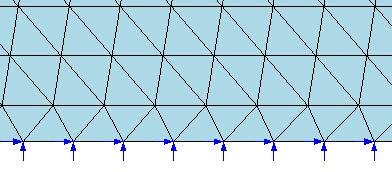
Phase 1: constraints applied at the lower edge of the model
On the other hand, pinned support with an axis perpendicular to that of the edge are applied at the lateral edges. In essence, movement in the horizontal direction is prevented, while movement in the vertical direction is permitted.
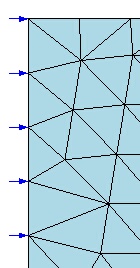
Phase 1: constraints applied at the lateral edges of the model
After clicking the ‘Add Constraints’ button, Phase 1 movements must be assigned by selecting ‘Fixed Nodes’ from the drop-down menu. This type of constraint must only be assigned with reference to Phase 1.
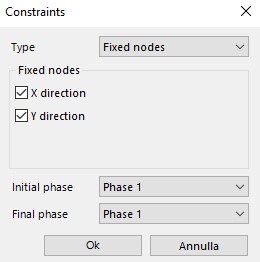
Phase 2
In this phase, the input accelerogram is assigned and the response spectrum is calculated. As a result of the accelerogram, seismic waves are generated that propagate within the model. These waves are reflected and amplified at the edges of the model. Since these edges do not exist in situ, the seismic waves generated by reflection at the edges are without physical meaning. For this reason, it is necessary to define appropriate constraints aimed at eliminating, or at least reducing, these effects. To do this, in the second phase, it is necessary to assign damping contours along the edges of the model, which have precisely the purpose of limiting reflection effects at the edges.

To do this, after selecting the edge nodes on which to apply constraints from the Tools panel, and clicking on ‘Add constraints’, the ‘Damping contours’ type must be selected.
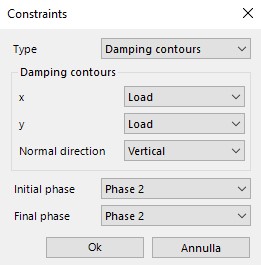
Damping contours, on the other hand, must only be assigned in Phase 2. The contours can be either Free or Load: in the Free case, the node is free to move in the direction in which it has been assigned without considering the damping effect; in the Load case, on the other hand, the node will move conditioned by the damping effect.
In addition, the displacements of the lower edge of the model must also be constrained. Specifically, it is necessary to prevent displacements in the vertical direction. This constraint can be assigned as indicated above for Step 1. Alternatively, the same constraint conditions can be applied by selecting the ‘Assigned displacements’ constraint type, as shown in the following figure.
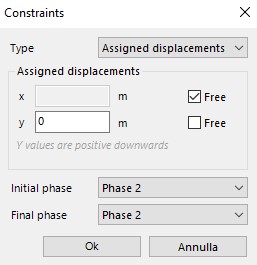
Finally, since in the second phase a seismic input will be assigned at the bottom edge of the model, it is necessary to prepare the model for the application of an accelerogram. For this purpose, after selecting the bottom edge nodes and ‘Add constraints’, it is necessary to assign the type ‘Assigned accelerations’, as shown in the following figure. The assignment of the accelerogram is described in the appropriate section.
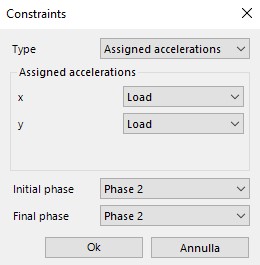
The following figure summarises the schematisation of the Phase 2 boundary conditions just described.

Phase 2: constraints applied at model edges
Nodi monitorizzati